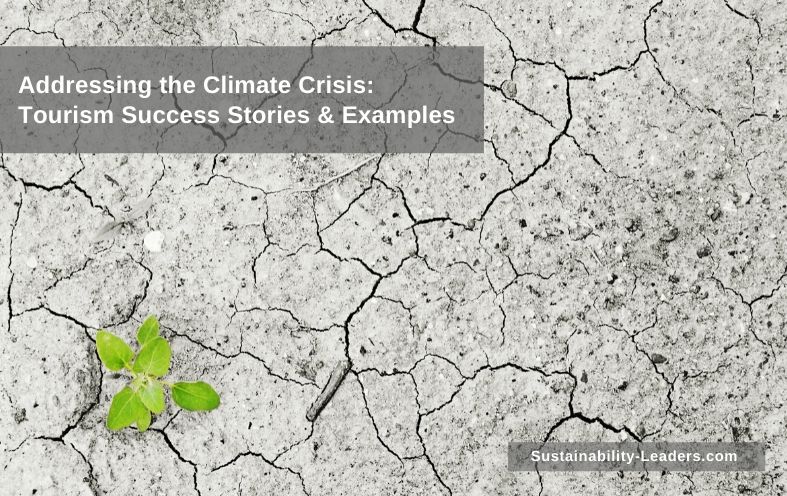
Voluntarily or otherwise, more and more destinations and tourism businesses are now investing in their sustainability, be it for increased resilience, maintaining the quality of products and experiences, or to meet market demands (supply chain pressure or preferences of discerning travelers).
Whereas some aspects of sustainability are fairly easy to implement – such as working with local communities and being gentle on the usage of natural resources, for instance – dealing with the climate crisis requires willingness and expertise of quite a different level.
The question is: which companies and destinations around the world are the leaders in actually addressing the climate challenge and are thus useful examples for others to follow?
That’s what we asked our panel of sustainable tourism specialists and below you find their answers (highlighted respondents are available to support you as consultants or speakers).
Our key takeaways:
- Guyana is a good example of how a comparatively small destination can address its travel climate impact, supporting its forests and local communities while avoiding mass tourism.
- Bhutan is another country that has managed to benefit from the visitor economy, without suffering from overtourism, among other by prioritizing the happiness of its citizens over any travel metrics.
- Copenhagen as a city destination is world-renowned for its bold approach to reducing its climate impact.
- One straight-forward example of an innovative measure is the reduction of diesel consumption in tourism businesses in developing countries.
- Many organizations are now actively engaged with helping tourism to address its climate footprint, including Ecotourism Australia, the Asian Ecotourism Network, and the Caribbean Community Climate Change Centre.
Brian Mullis
Interview | Speaker profile
Guyana became a Party to the Climate Convention in 1992 (ratified in 1994) and the subsequent Paris Agreement in 2016 and acceded to the Kyoto Protocol of the Convention in 2003. The country’s Green State Development Strategy supports low carbon and green growth.
Guyana also has two implementation strategies namely:
- the Climate Resilient Strategy and Action Plan (CRSAP) drafted in 2015
- the National Climate Change Policy and Action Plan (NCCPAP) 2020-2030 drafted in 2019 to address the effects of climate change
The Government of Guyana has reported on climate mitigation, adaptation, and mitigation activities via an Initial (2002) and Second (2018) National Communication to the United Nations Framework Convention on Climate Change (UNFCCC) which are accessible via the Guyana Office of Climate Change website. Preparation of the Third National Communication under the UN Framework Convention on Climate Change (TNC) is underway.
In the tourism sector, the Guyana Tourism Authority and Department of Tourism in Guyana have committed to developing and implementing a Climate Adaptation and Resilience Strategy that provides clear and practical solutions on how the tourism sector in Guyana can best adapt to and prepare for the impacts of climate change.
The strategy will have an emphasis on sensitising governmental, community, tourism private sector, and other leaders to the most credible science and sea-level rise analyses for Guyana with an emphasis on the concentration of infrastructure in Georgetown and along the coast. In the short-term, it is critical that we:
- Ensure that tourism development and associated infrastructure be evaluated and informed by the most recent and reliable data in order to determine the true return on investment potential.
- Continue to promote energy efficiency, renewable energy, and sustainable policy and management initiatives in the tourism sector in collaboration with CARICOM, Guyana Energy Agency, the Office of Climate Change, and the Department of Energy.
- Advocate for and foster innovative energy-efficient and renewable energy investments and self-financing mechanisms.
- Secure buy-in for renewable energy and energy efficiency within the accommodations sector.
- Implement demonstration projects to illustrate how it is possible to empower sustainable energy production and use through the tourism value chain in municipalities, protected areas, and receptive indigenous communities.
- Reduce the demand for fossil fuels for transport and for electricity generation from the tourism industry.
 Jonathon Day
Jonathon Day
Interview | Speaker profile
At a destination level – Queensland, Australia has done an outstanding job of raising the importance of climate change to the tourism industry. The state government has created a framework for adaptation and encouraged sectors to develop their own strategies.
The Queensland Tourism Industry Council, working with industry stakeholders, has developed the Queensland Climate Adaptation Strategy. The program combines both the best science and broad-based consultation with the tourism industry.
Highlighting companies that are committed to reducing GHG and celebrating their work is an important part of encouraging new corporate behaviors. Ecotourism Australia has developed three levels of certification for tourism businesses – Climate Action Business, Climate Action Innovator, and Climate Action Leaders.

Kirsi Hyvaerinen
Interview | Speaker profile
Let’s see which businesses and organisations register and what their plans and actions are, for example on this page. Communities are building around the climate crisis topic to share methods, news, experiences, and education.
Last September, the Climate Action Leaders in adventure travel got started. Today I would suggest joining our LinkedIn group and get the bi-monthly Bulletin via cl*****@ad*************.biz.
In certified destinations that use the GSTC standards via Green Destinations or other accredited certification bodies, climate-relevant action is definitely happening.
Here in Montenegro, this project took the first steps in the region. And as the first destination to make the move, Tivat has chosen to improve in all aspects of sustainability with Green Destinations, which has already proven to work well in this region. The National Tourism Organisation is planning to present the program to all local tourism organizations in the country as soon as personal work meetings are possible.
 Willy Legrand
Willy Legrand
Interview | Speaker profile
Considering that sustainability covers the environmental, social, and economic pillars, it is difficult to settle for a few examples of best practices. Since my focus lies particularly towards the hotel sector, I can share a few examples of industry players that are pushing the boundaries in including the climate crisis as a core aspect of their sustainability strategy.
Large hotel groups have the power to scale up initiatives across the globe. However, when exploring ideas, solutions, and strategies in proactively addressing the climate crisis and in line with climate goals (e.g. Paris Agreement) or having a net positive impact on their surroundings (e.g. biodiversity preservation), the list of best practices shortens greatly.
Some dedicated entrepreneurs have made sustainability an integral part of their business venture. The five hotels below have been selected for their endeavors towards either mitigating impacts in times of climate emergency or biodiversity collapse.
- The Explorer Hotel Group with nine hotels located in mountainous regions of southern Germany and Austria operates entirely carbon neutral, based on a combination of certified passive-house building architecture and renewable energy production. The resulting carbon-neutrality is in the DNA of this small hotel group, which has ambitious expansion plans.
- Similarly, the Boutiquehotel Stadthalle in Vienna, Austria shows the possibility of carbon neutrality within an urban setting. Being Europe’s first zero-energy balance hotel, the sustainability features include an organic breakfast with zero-packaging, upcycled furniture in public spaces and rooms, and lavender rooftop. The Boutiquehotel Stadthalle has integrated the United Nations Sustainable Development Goals (SDGs) (2015-2030) into its sustainability strategy.
- Inkaterra in Peru is a pioneer in combining hospitality services, nature conservation, education, and local community involvement. Biodiversity and ecosystems are key mitigation tools but also directly affected by climate emergency. Inkaterra is committed to mitigating the effect of deforestation in the Amazon rainforest through the preservation of Peru’s first ecological concession, with more than 10,000 hectares of virgin rainforest allowing for carbon sequestration. The seven properties all contribute to sponsoring biodiversity inventories in natural areas where they are located.
- Chumbe Island Coral Park Ltd. (CHICOP) is a not-for-profit private nature reserve developed for the conservation and sustainable management of Chumbe Island off Zanzibar. Similar to Inkaterra, Chumbe Island Coral Park tourism income supports conservation, research, and comprehensive environmental education programs for local schools. The seven bungalows are designed and operated to have a near zero-impact. 90% of Chumbe Island is covered by an undisturbed tropical dry forest assigned with the status of ‘reserve’. Fragile ecosystems, vital to our planet’s biodiversity, require attention and hospitality ventures that can make a difference.
- Finally, Soneva is one of the few hotel companies to measure carbon emissions into three ‘scopes’ as classified by the Greenhouse Gas Protocol.
- Scope one is the direct emissions from the hotel such as fuel combustion for on-resort energy production.
- Scope two are the indirect emissions from purchased electricity consumed by the hotels
- Scope three are the other indirect emissions from outsourced activities, such as the emissions associated with the procurement of food to the hotels or the guests’ travel for example.
This is a model, which needs to be replicated by other hotel companies to have a clearer picture of the carbon footprint of a company. And subsequently limit, reduce, and mitigate the remaining emissions through offsets.
Amine Ahlafi
‘Discover green, clean, and safe Copenhagen’ through a strategic framework of sustainability combined with the world’s most ambitious climate policies with the goal of being the first carbon-neutral capital city by 2025.
‘Healthy and sustainable holiday in Vienna’ through a range of initiatives toward sustainability involving all the tourism stakeholders.
Anna Spenceley
Interview
In Africa, the company Wilderness Safaris has been converting camps to solar power. Mombo Camp in Botswana switched from using diesel generators to 100% solar energy in May 2012, with a backup generator on-site to provide additional electricity during times of excessive demand or bad weather.
Following the capital investment of approximately USD 860,000 in solar panels, there was an 82% reduction in annual diesel use, from 108,981 litres to 19,309 litres per annum. In terms of carbon emissions from electricity production, 50 tonnes of CO2 were emitted directly in 2017, compared to 287 tonnes in 2012.
This is a considerable improvement by just one company – so imagine what kind of impact we could have if this became the norm for the travel industry.
This and many other examples such as these can be found in the book by Sue Snyman and myself on Private sector tourism in conservation areas in Africa.
Partnerships addressing climate change include Tourism Declares a Climate Emergency. This is a new collection of travel companies, organisations, and professionals that recognise the urgency of climate change, and are accepting responsibility, and aim to act and collaborate to find solutions.
There are currently 81 signatories, which include the Adventure Travel Trade Association (ATTA) and Exodus travels. As you read through some of these declarations, you can see how they are proactively committing to climate crisis strategies.
Jonathan Tourtellot
Numerous destinations provide incentives and disincentives that favor renewable non-carbon energy. The biggest factor is government buy-in.
Kevin Teng
Interview
Quite a few hotels in Singapore work with the government’s National Climate Change Secretariat.
Masaru Takayama
Interview
We, Asian Ecotourism Network, have made the declaration among ourselves in January this year. We are trying to demonstrate to the industry to raise awareness and encourage them to take action based on the declaration. We will need to celebrate the ones that take action based on this declaration as we need to mainstream the idea into all the tourism sectors.
Another one that I am involved is with the Japan Alliance of Responsible Travel Agencies (JARTA) and Travelife to introduce CARMACAL, a user-friendly application which allows our Japanese tour operators and other businesses to measure the complete and detailed carbon footprint of their tour packages, enabling the integration of carbon management into their daily operations.
It is already widely used in Europe and we want to do the same in our part of the planet. To achieve this, we have secured funding from the Japanese Environmental Restoration and Conservation Agency.
Natalia Naranjo Ramos
Interview
The Caribbean and the small islands are talking about the climate crisis for a while. They have a Caribbean Community Climate Change Centre and governments are taking steps to:
- promote renewable energy
- energy efficiency
- to improve mobility
- water infrastructure
- community-level physical and social infrastructure to reduce greenhouse gas emissions
- to improve resilience to the impacts of climate change
Besides these regional efforts locally in Pijao, Quindío in Colombia; within the frame of the Cittáslow brand, the Pijao Cittáslow Foundation is looking for people interested in donating funds to buy land where the water source of the town is. They know the importance to conserve and protect this land as the risks of landslides are getting higher and the possibility of lack of water resources is a huge threat.
Rachel Dodds
Interview
Intrepid Travel calculates the carbon emissions for each trip they offer so one can clearly see the impact. Most adventure operators also use local buses for transport and lower carbon-intensive suppliers.
Treadright, the foundation for TravCorp is undertaking efforts to calculate and also offset all past and current impacts.
Many companies are also now engaging the consumer to also become a part of strategies. For example, the Gladstone Hotel in Toronto, Canada uses renewable power and adds a fixed amount to all hotel bills which is visible to customers but they have the option to opt-out. They provide information on why it is a separate line item on the bill to educate their guests about what it is and why they are doing it. They have very high uptake.
Steve Noakes
Interview
For a marine tourism enterprise, Sailaway Port Douglas is doing a very good job. They hold the Advanced Ecotourism Accreditation (Ecotourism Australia) and is recognised as a Climate Action Leader. Sailaway employs qualified marine biologists and makes daily records that are sent back to Great Barrier Reef Marine Park Authority to help with a program called “Eye on the Reef”.
Our tourism experience has credibility and accurate interpretation from the crew is imperative to guest interaction. This expertise helps us pass on a better level of knowledge to guests who may be experiencing the underwater environment for the first time, and even for those who consider themselves to be knowledgeable already.
Vik Nair
One of the best countries (destinations) that the world can emulate is Bhutan. The focus of all strategies in Bhutan is ‘conservation of natural and cultural heritage, which improves the wellbeing of their citizens within the overall concept of Gross National Happiness (GNH), rather than GDP’.
Bhutan is a small, landlocked country. For Bhutan, climate change is a serious challenge to sustainable development and the livelihoods of its people that depend on farming, hydropower production, and tourism, which can be severely impacted.
Tourism is one of the largest foreign exchange earning industries in Bhutan. Nonetheless, the sustainable strategy adopted by Tourism Bhutan to address the climate crisis is by controlled pricing policy – High-Value Low Volume (HVLV). With this policy, Bhutan has succeeded in effectively balancing the revenue and the environment of the country.
The HVLV strategy ensures all tourists only come into Bhutan via a locally organised packaged tour. The main aim of all the tours is to limit high-end tourists who will provide more revenue with the least exploitation of environment and culture. Hence, the revenue collected from these high-end tourists will be used to manage the resources more sustainably.
Bhutan also made an ambitious pledge at the Paris Climate Summit resulting in the nation’s forests absorbing three times more CO2 emissions than its population emits. Hence, Bhutan is the world’s most ‘carbon negative’ country.
Further, Bhutan has a solid National Adaptation Plan (NAP) to adapt to the adverse impacts of climate change through a series of independent projects and programmes. monitoring and evaluation system to assess climate resilience. With the NAP, a more comprehensive monitoring and evaluation system is in place to assess climate resilience. This indirectly resulted in tourism businesses and tourist destinations in Bhutan to be more responsible and sustainable.
More about the sustainable tourism expert panel here – including previous sessions and answers to some of the most pressing issues linked to making tourism more sustainable.
Do you know of destinations in addition to those mentioned above which have taken exceptional measures in addressing their climate impact or sustainability? Let us know!












